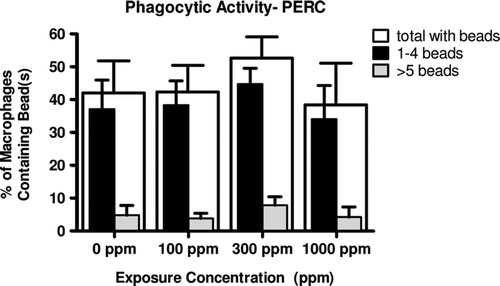Figures & data
Table 1. General design for TCE and PERC inhalation studies outlining separate groups of animals for evaluation of the SRBC antibody response.
Table 2. Terminal body weights and absolute and relative organ weights for animals exposed to TCE.
Figure 1. Results of the SRBC antibody forming cell (AFC) assay for TCE. Exposure to TCE resulted in a slight decrease in the number of spleen cells that was without dose response and was not statistically significant (a). No effect on the AFC responses was noted for the 100 and 300 ppm groups, while the 1000 ppm group had a 71% and 64% decrease in the (b) AFC/spleen and (c) AFC/106 splenocytes responses when compared to controls. The positive control CYP resulted in the expected decreases in spleen cell counts and AFC responses. Values represent the mean (± SE) of eight animals. * p < 0.05.

Table 3. Terminal body weights and absolute and relative organ weights for animals exposed to PERC.
Figure 2. Phagocytic activity of pulmonary alveolar macrophages (PAM) following PERC exposure. Exposure to PERC did not result in any alterations in ability of PAM to phagocytize fluorescent bead(s) when compared to controls. The wide un-shaded (white) bars represent the total percentage of PAM containing any number of beads; the counts were further stratified into those containing 1–4 beads (black bars) and those containing ≥ 5 beads (grey bars) to further assess any reduction in activity. Values represent the mean (± SD) from cells of eight animals.

Figure 3. Results of the SRBC antibody forming cell (AFC) assay for PERC. Exposure to PERC did not result in a treatment-related effect on the (a) number of spleen cells or (b and c) AFC responses. The positive control CYP resulted in the expected decreases in spleen cell counts and AFC responses. Values represent the mean (± SE) of eight animals. * p < 0.05.
